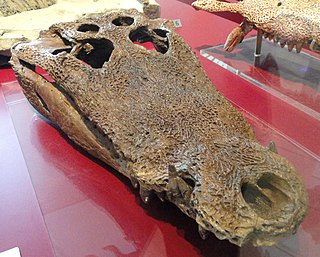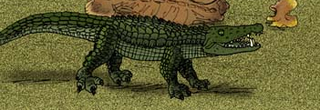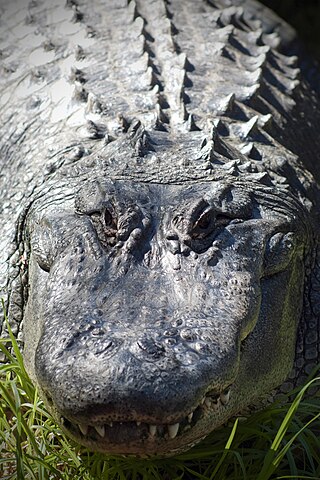
Allodaposuchus is an extinct genus of crocodyliforms that lived in what is now southern Europe during the Campanian and Maastrichtian stages of the Late Cretaceous. Although generally classified as a non-crocodylian eusuchian crocodylomorph, it is sometimes placed as one of the earliest true crocodylians. Allodaposuchus is one of the most common Late Cretaceous crocodylomorphs from Europe, with fossils known from Romania, Spain, and France.

Boverisuchus is an extinct genus of planocraniid crocodyliforms known from the middle Eocene of Germany and western North America. It was a relatively small crocodyliform with an estimated total length of approximately 2.2–3.6 metres (7.2–11.8 ft).
Wannaganosuchus is an extinct genus of small alligatorid crocodilian. It was found in Late Paleocene-age rocks of Billings County, North Dakota, United States.

Leidyosuchus is an extinct genus of alligatoroid from the Late Cretaceous of Alberta. It was named in 1907 by Lawrence Lambe, and the type species is L. canadensis. It is known from a number of specimens from the middle Campanian age Dinosaur Park Formation. It was a medium-sized alligatorid, with a maximum skull length greater than 40 centimeters (16 in).

Eusuchia is a clade of neosuchian crocodylomorphs that first appeared in the Early Cretaceous, which includes modern crocodilians. Along with Dyrosauridae and Sebecosuchia, they were the only crocodyliformes who survived the K-T extinction.

Alligatoroidea is one of three superfamilies of crocodylians, the other two being Crocodyloidea and Gavialoidea. Alligatoroidea evolved in the Late Cretaceous period, and consists of the alligators and caimans, as well as extinct members more closely related to the alligators than the two other groups.

Allognathosuchus is an extinct genus of alligatorine crocodylian with a complicated taxonomic history. It was named in 1921.

Acynodon is an extinct genus of eusuchian crocodylomorph from the Late Cretaceous, with fossils found throughout Southern Europe.
Hylaeochampsa is an extinct genus of eusuchian crocodylomorphs. It is known only from a partial skull recovered from Barremian-age rocks of the Lower Cretaceous Vectis Formation of the Isle of Wight. This skull, BMNH R 177, is short and wide, with a eusuchian-like palate and inferred enlarged posterior teeth that would have been suitable for crushing. Hylaochampsa was described by Richard Owen in 1874, with H. vectiana as the type species. It may be the same genus as the slightly older Heterosuchus, inferred to have been of similar evolutionary grade, but there is no overlapping material as Heterosuchus is known only from vertebrae. If the two could be shown to be synonyms, Hylaeochampsa would have priority because it is the older name. Hylaeochampsa is the type genus of the family Hylaeochampsidae, which also includes Iharkutosuchus from the Late Cretaceous of Hungary. James Clark and Mark Norell positioned it as the sister group to Crocodylia. Hylaeochampsa is currently the oldest known unambiguous eusuchian.

Crocodyliformes is a clade of crurotarsan archosaurs, the group often traditionally referred to as "crocodilians". They are the first members of Crocodylomorpha to possess many of the features that define later relatives. They are the only pseudosuchians to survive the K-Pg extinction event.

Kentisuchus is an extinct genus of gavialoid crocodylian, traditionally regarded as a member of the subfamily Tomistominae. Fossils have been found from England and France that date back to the early Eocene. The genus has also been recorded from Ukraine, but it unclear whether specimens from Ukraine are referable to Kentisuchus.
Listrognathosuchus is an extinct genus of alligatoroid crocodilian. Fossils date back to the middle Paleocene epoch. In 1997, the generic name replaced that of Leidyosuchus for the species L. multidentatus. "L." multidentalis was first described by Charles Mook in 1930 on the basis of the holotype AMNH 5179, consisting of a partial vertebral column, mandible, partial left ilium, and left tibia, found from a locality in Torrejon Arroyo, New Mexico.

Thoracosaurus is an extinct genus of long-snouted eusuchian which existed during the Late Cretaceous and Early Paleocene in North America and Europe.

Planocrania is an extinct genus of eusuchian crocodyliforms from what is now China. Two species are currently known to belong to the genus.

Stangerochampsa is an extinct genus of globidontan alligatoroid, possibly an alligatorine or a stem-caiman, from the Late Cretaceous of Alberta. It is based on RTMP.86.61.1, a skull, partial lower jaws, and partial postcranial skeleton discovered in the late Campanian–early Maastrichtian-age Horseshoe Canyon Formation. Stangerochampsa was described in 1996 by Wu and colleagues. The type species is S. mccabei. The generic name honors the Stanger family, the owners of the ranch where the specimen was found, and the species name honors James Ross McCabe, who discovered, collected, and prepared it. Stangerochampsa is described as "small to medium–sized"; the type skull is 20.0 centimetres (7.9 in) long from the tip of the snout to the occipital condyle, and is 13.0 centimetres (5.1 in) wide at its greatest, while the thigh bone is 14.2 centimetres (5.6 in) long. It had heterodont dentition, with large crushing teeth at the rear of the jaws.

Gavialoidea is one of three superfamilies of crocodylians, the other two being Alligatoroidea and Crocodyloidea. Although many extinct species are known, only the gharial Gavialis gangeticus and the false gharial Tomistoma schlegelii are alive today, with Hanyusuchus having become extinct in the last few centuries.

Brevirostres is a paraphyletic group of crocodilians that included alligatoroids and crocodyloids. Brevirostres are crocodilians with small snouts, and are distinguished from the long-snouted gharials. It is defined phylogenetically as the last common ancestor of Alligator mississippiensis and Crocodylus niloticus and all of its descendants. This classification was based on morphological studies primarily focused on analyzing skeletal traits of living and extinct fossil species, and placed the gharials outside the group due to their unique skull structure, and can be shown in the simplified cladogram below:

Planocraniidae is an extinct family of eusuchian crocodyliforms known from the Paleogene of Asia, Europe and North America. The family was coined by Li in 1976, and contains three genera, Boverisuchus, Duerosuchus and Planocrania. Planocraniids were highly specialized crocodyliforms that were adapted to living on land. They had extensive body armor, long legs, and blunt claws resembling hooves, and are sometimes informally called "hoofed crocodiles".

Allodaposuchidae is an extinct clade of eusuchians that lived in Europe during the Late Cretaceous (Santonian-Maastrichtian).

Lohuecosuchus is an extinct genus of allodaposuchid eusuchian crocodylomorph that lived during the Late Cretaceous in what is now Spain and southern France.






















